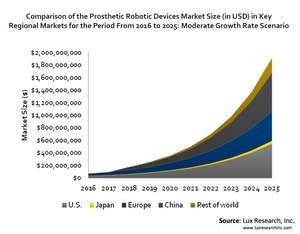BOSTON, MA--(Marketwired - Mar 29, 2016) - Prosthetic and therapeutic robotic devices will grow into a $1.9 billion and $1.7 billion market by 2025 respectively, as an aging population demands better quality of life and superior performance, according to Lux Research.
Predictably, the largest markets for the prosthetic robotics -- devices such as bionic arms and legs -- will reside in developed countries in Europe and the U.S., but China will comprise nearly one-third of the total 2025 market, more than any other country.
Therapeutic robotics -- devices that help a range of conditions from strokes to spinal cord injuries -- are less sensitive to the availability of insurance reimbursement, so most of this market will be from sales to centralized rehabilitation centers.
"Robotics is rapidly entering the future of health care as a tool that will enable more advanced and personalized care for millions of patients. As longevity increases, more people are demanding better rehabilitative care," said Maryanna Saenko, Lux Research Analyst and lead author of the report titled, "Automating the Road to Recovery - How the Rehabilitation Robotics Market Is Changing the Future of Health Care."
"The rapid rise in patient numbers degrades medical providers' ability and further stresses the need for more robotic technologies to assist in treatment," she added.
Lux Research analysts evaluated the path to market for rehabilitation robotics and projected its growth over the next decade. Among their findings:
- Elderly population grows. Global life expectancy has risen to 78.7 years, compared to 75.4 in 1990. Additionally, the number of people aged 65 or over is projected to rise to nearly two billion in 2050. This will raise the population of those with debilitating diseases requiring rehabilitative care.
- Survivors of debilitating disease on the rise. The number of patients needing rehabilitative robotics is on the rise not only because people are living longer but also because incidences of conditions like stroke are increasing, and life expectancy of those affected is growing. According to the American Heart Association, the number of stroke survivors is to rise by 68% by 2050, from the current 665,000. Similarly, survivors of spinal cord injuries are growing.
- Opportunity for device integrators. The therapeutics market lacks existing infrastructure, making it a fertile ground for new technologies despite challenges arising from medical reimbursement. An even larger opportunity exists for device integrators because profit margins are significantly higher than for makers of finished products in the medical devices industry.
The report, titled "Automating the Road to Recovery - How the Rehabilitation Robotics Market Is Changing the Future of Health Care," is part of the Lux Research Autonomous Systems 2.0 Intelligence and the Digital Health and Wellness Intelligence services.
About Lux Research
Lux Research provides strategic advice and ongoing intelligence for emerging technologies. Leaders in business, finance and government rely on us to help them make informed strategic decisions. Through our unique research approach focused on primary research and our extensive global network, we deliver insight, connections and competitive advantage to our clients. Visit www.luxresearchinc.com for more information.
Contact Information:
Contact:
Carole Jacques
Lux Research, Inc.
617-502-5314
carole.jacques@luxresearchinc.com
